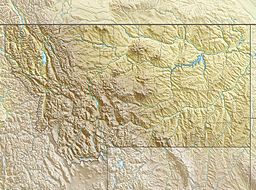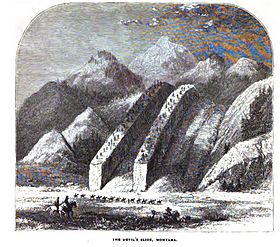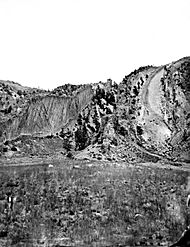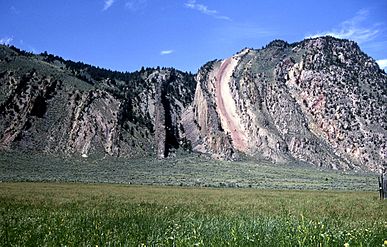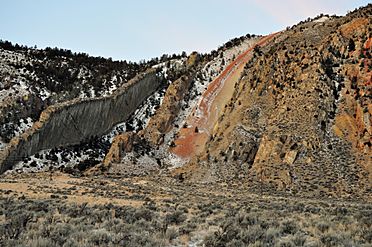Devil's Slide (Montana) facts for kids
Quick facts for kids Devils Slide |
|
|---|---|
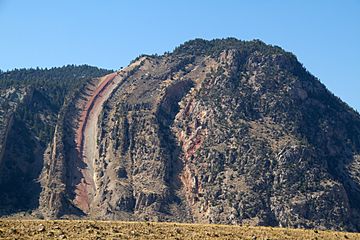
Devils Slide in 2012
|
|
| Highest point | |
| Elevation | 6,499 ft (1,981 m) |
| Parent peak | Cinnabar Mountain |
| Geography | |
| Parent range | Gallatin Range |
| Topo map | Electric Peak |
The Devil's Slide is a really cool and unique rock formation. You can find it on the side of Cinnabar Mountain in Gallatin National Forest, which is in Park County, Montana. It's just north of Yellowstone National Park.
This amazing rock formation is easy to spot from Highway 89. It was formed over a very long time from different layers of rock, like limestone, sandstone, and quartzite. These layers were pushed up to stand almost straight up. Over time, wind and water wore away the softer parts, leaving behind the harder, more resistant rock layers that look like a giant slide!
How Devil's Slide Got Its Name
In the past, not many explorers had traveled far into the Yellowstone River valley. In 1869, a group called the Cook-Folsom-Peterson Expedition passed by the Devil's Slide. They wrote about it in their journals but didn't give it a name.
Then, in August 1870, another group, the Washburn–Langford–Doane Expedition, saw the formation. They were the ones who named it The Devil's Slide.
Nathaniel P. Langford, who was part of that expedition, described the formation in his book Wonders of the Yellowstone in 1871. He wrote about how it looked like two tall, parallel rock walls sticking out from the mountain. These walls were about 125 feet high and stretched for 1,500 feet up the mountain. He was amazed by how smooth and even the sides were, almost as if they were built by people, not nature.
Langford explained that the wind and water had worn away the entire mountainside around these hard rock layers. This left the two strong, vertical walls standing tall. One of his companions thought the formation looked like a "Devil's Slide," and the name stuck!
-
1871 illustration of Devil's Slide by Thomas Moran
-
First photo of Devil's Slide by William Henry Jackson, 1871


